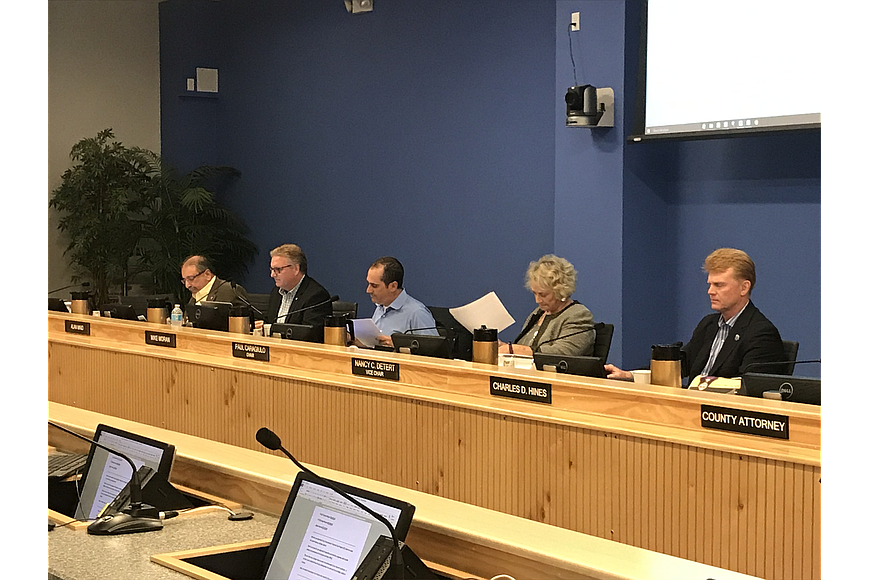- April 23, 2024
-
-
Loading

Loading

The County Commission voted to take the next steps toward levying a 5% public service tax on utilities for fiscal year 2018, in an effort to keep the budget balanced without raising the millage rate — but even with the new tax, it will not yield so much money that the county could begin building its reserves back up.
The tax would be levied on electricity, water and gas for customers in unincorporated areas of the county. If approved in September after public hearings, the tax would raise more than $5 million in 2018, and about $11 million in the following years. Although it’s new for some residents, those living in the city of Sarasota are already paying a 10% tax on public utilities.
The Aug. 21 meeting was the third public workshop about the budget, and the public service tax has been on the table since the beginning, even as the commissioners asked to see other changes to the original budget that was proposed by the county administrator.
In fulfilling the County Commission’s request from June, Sarasota staff presented a slightly updated budget for fiscal year 2018 that includes cuts to a few government departments in order to avoid raising the millage rates. The small changes, coupled with levying the public service tax, allow the county to keep the millage rate where it is and postpone any shortfalls until fiscal year 2020, but still leaves the reserves running low.
“We can’t plan year-to-year going forward. We are going to put ourselves in an emergency situation,” Commissioner Charles Hines cautioned at the Aug. 21 meeting. “We’re not meeting our goal of rebuilding that economic uncertainty fund.”
Each county office presented its budget at a two-day workshop in June. County Administrator Tom Harmer and his staff recommended that those budgets, coupled with a slight increase to the millage rate and a 5% tax levied on public utilities, be approved by the County Commission.
The Commission decided later that month not to raise the millage rate for 2018, prompting staff to figure out where else they could cut in the operating budgets of different departments. The Commission hasn't raised the millage rate in decades.
Staff came back with budgets that were reduced for several departments from what was originally proposed for the year. The State Attorney’s and Public Defender’s offices reduced their budgets for a combined total of $121,500. Parks, Recreation and Natural Resources, SCAT, Health and Human Services, Planning and Development Services, Public Works, Emergency Services, the county attorney and the UF/IFAS Extension all reduced their budgets, saving $1.1 million. In total, the reductions came to almost $1.3 million.
Even after these cuts to the original budgets were revealed, Commissioner Michael Moran was still not satisfied, making a point of asking staff members what cuts could be made to staff benefits such as health care. He said he was not comfortable making any revenue increases, like approving the 5% public utilities tax, until he was confident there were no other places to make cuts in the government’s budget.
Additionally, about $5.4 million was left over from fiscal year 2017 — up from the estimated $3 million presented at June’s meetings. This one-time amount and the departmental budget reductions helped to offset the same costs that the millage rate increase would.
However, despite these savings, the budget shortfall for each year will continue to increase if the board approves this budget. Like with the options presented in June, the budget would have a shortfall, or a negative balance, starting in fiscal year 2020. However, with June’s budget option, that deficit would decrease each subsequent year. With the current option, the deficit increases each year after fiscal year 2020.
This is something Vice Chair Nancy Detert noticed, and she brought up the importance of having a “sustainable” budget.
“Otherwise, you’re just kicking the can down the road and you’re making this budget some future commissioner’s problem,” she said.
Commissioners Hines agreed, addressing the necessity of planning for a future disaster or economic downturn. Replenishing the county’s reserves was a goal of the Commission, but that may be eclipsed by commissioners’ staunch opposition to raising taxes.
“None of us have a crystal ball.” Commissioner Al Maio said. “We don’t know what’s going to face us in the future, and we’ll react to that.”
The Commission voted 4-1, with Moran opposing, to advertise the 5% public utilities increase for a Sept. 11 public hearing.